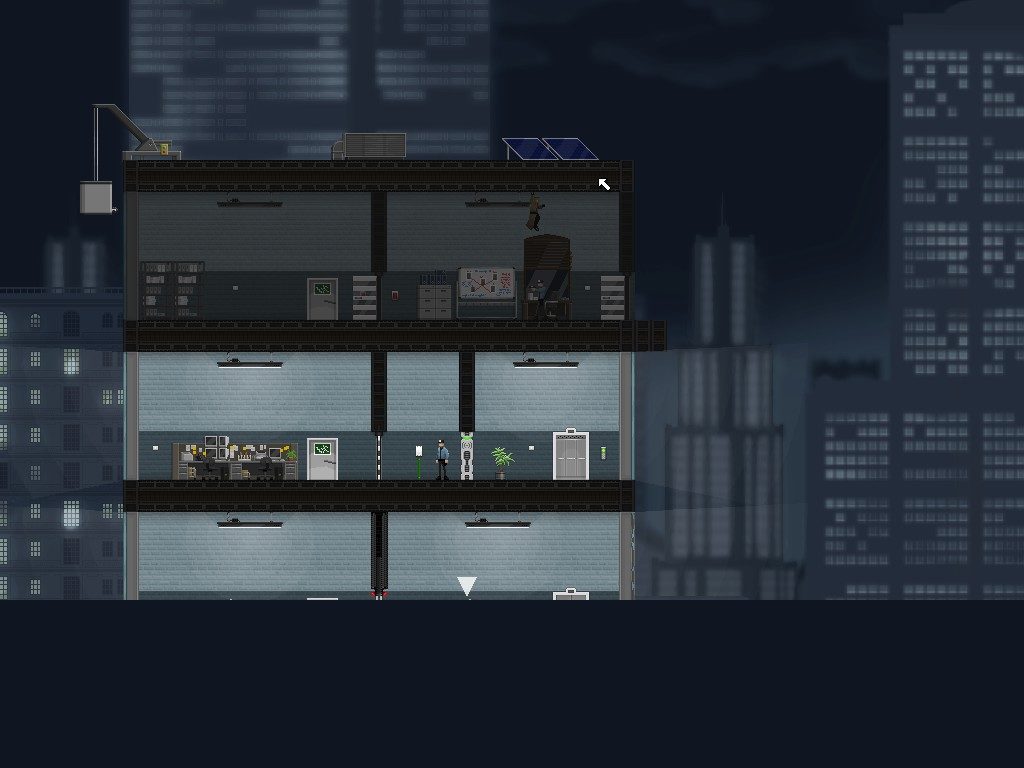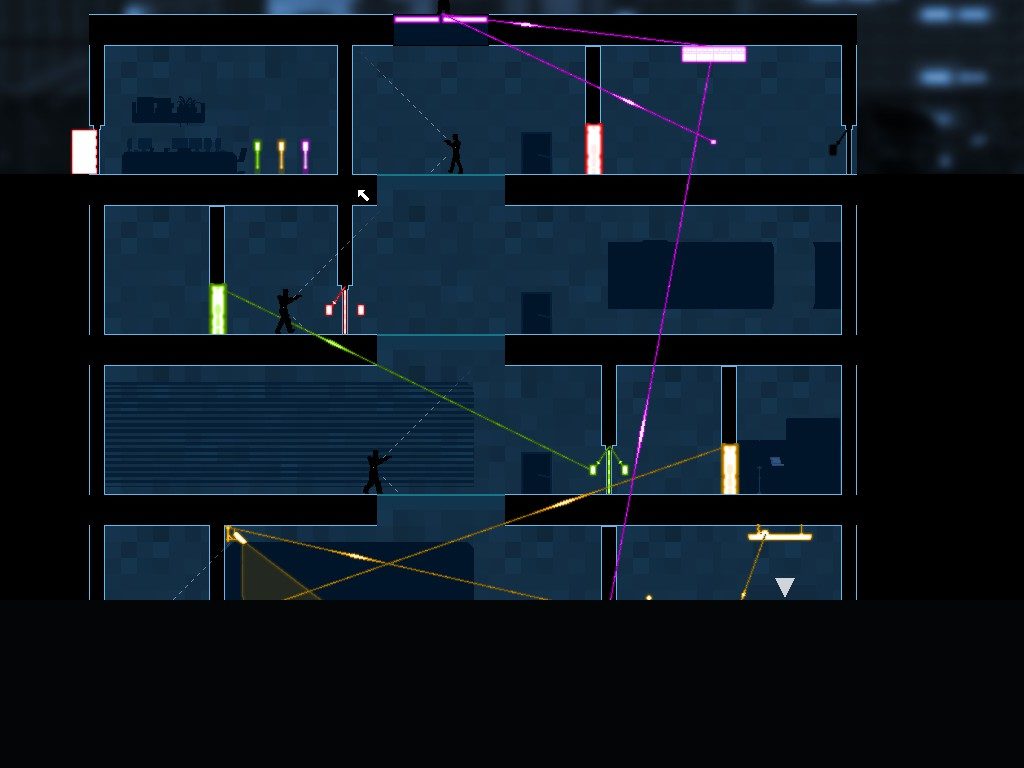It’s hard being a freelancer these days. Whether in journalism, the arts, construction, even espionage, the life of an independent contractor can be a tough road to hoe nowadays, especially when a simple job goes wrong and puts you on the hook for a homicide you didn’t commit. And this is where you come in, in today’s piece of the Big Steaming Pile, 2013’s Gunpoint by Suspicious Developments.
Gunpoint puts you in the snazzy trench coat and fedora of Richard Conway, a freelance spy-for-hire who finds himself in a sticky situation after a murder takes place at the site of a simple smash-and-grab job. Unfortunately for Richard, he is the only other person spotted on surveillance besides the victim, which forces him to attempt to surreptitiously clear his name. Complicating matters further, Richard is then hired to locate the man seen in the security video, putting him in a spot where he has to vindicate himself while simultaneously hunting himself, all while seeing how far down the rabbit hole the actual murder goes.
The gameplay itself can best be described as a mixture of stealth action and puzzle-solving. Your objective in most missions is to obtain some sensitive material from a secure location, nestled away behind locked doors and armed guards. Richard himself eats it in one shot, and the guards are some remarkably accurate foes, so you’ll be required to approach your objectives through misdirection rather than confrontation. To this end, you are very much equipped for the job, as you’ll be unlocking a laundry list of gadgets and special abilities to assist you. The first and most important of these is the Crosslink, which allows you to rewire different electronic devices and link them together, for example, if there’s a guard facing a door you need to go through, but an elevator behind the guard, you can rig a light switch in the room you’re in to call the elevator, distracting the guard and allowing you to get the jump on your quarry. Flicking the mouse wheel takes you from a normal view into Crosslink Mode, where you can see the various electric linkups throughout the building and see what you can tinker with. However, you don’t get entirely free reign, components can only be linked with those of the same color, and some circuits are secure, requiring a different tool entirely.

While that may sound convoluted on paper, it’s a surprisingly intuitive system to pick up, and the learning curve is balanced exceptionally well to where new elements and concepts are introduced to you in such a way that it doesn’t feel forced or overly tutorial-y, but you don’t wonder what the hell you’re supposed to actually do with something you’re presented. Later items like the Longshot, which allows you to wire objects to enemies’ guns, or the Prankspasm, which allow you to jury-rig electrocution traps, create some intriguing possibilities, but on the plus side, they feel more like tools designed to assist you instead of plot elements you are absolutely required to have to progress. Aside from your electronics prowess, Richard is something of a freak athlete, capable of leaping across great distances and up great heights, allowing you to scale up the sides of buildings, as well as through windows to create a new point of entry or an improvised escape route.
Make no mistake, you will have to worry yourself with exit strategy, because your opposition is far from a collection of inept doormats. Guards come in three different flavors – normal guards who you can pounce on from behind and knock out with your fists; Enforcers who can only be neutralized by booby trap, firearm, or tackling off of the side of a building; and Professionals, who dress like Secret Service agents and are wholly capable of punching your ticket even if you’re obscured by darkness. These guards can and will react to indicators of your presence; they will seek out and flip light switches if the lights go out, notice doors opening and closing around them, investigate the sounds of breaking glass, and congregate around areas where alarm bells are ringing.
You can use these behaviors to your advantage, as the guards, while relatively bright, are also on the predictable side, and luring a guard through a motion detector you’ve rigged to open a locked door or flip a light switch you’ve linked to a booby trap somewhere else is decidedly workable. If worst comes to worst, you have the option of purchasing a handgun to deal with foes in the most direct way possible, but this is definitely intended as the last-ditch option, as not only will other guards be on their way to check out the noise, but the police will be called, giving you a hard cap of about thirty seconds to make your escape from the level before reinforcements arrive to block the exits.

Another highlight shining brightly for Gunpoint is the presentation. The graphics are a largely 8-bit inspired and intentionally pixellated, and the constant rain and darkness in the background adds to the sort of NES noir vibe. Richard and the other characters are animated quite well despite the low-res art style, and it never gets old to see Richard make a bullfrog leap several stories up and blasting through a plate glass window. The building interiors are largely the kind of bland corporate veneer you’d expect, which also plays into the motif of you being something of an anonymous ghost-like operative that functions in the shadows and cracks of society. The sounds are quite crisp and vivid, especially the weird sort of electric hum that plays when you enter Crosslink Mode. One thing that sticks out and is quite enjoyable is the very tongue-in-cheek approach to the plot and the characters. Richard has a very sharp but dry wit that comes across in mission briefings and dialogue, and you get the impression that he uses a healthy dose of cynicism to paper over the increasing desperation of his situation. It never really descends into outright farce by any stretch, but this is far from a serious simulation of corporate/industrial espionage.
Of course, there are some aspects of Gunpoint I found a little lacking. For one, while you do have quite a bit of operational freedom, and there are multiple solutions to different problems, you do kinda get the impression along the way that there is supposed to be one most correct path through each level and anything you do differently is deviation from the plan instead of rewarding you for thinking on your feet. Also, the guards, while as I noted, are decently intelligent and also rather predictable, can be a bit too easy to manipulate. To use the elevator distraction example from above, when the guard turns to notice the now open elevator door, he will stay in that spot until something else grabs his attention, meaning that there’s not a lot of pressure to trigger something and then quickly take advantage of it; and in fact, the only real hard time limit you’re put under is if you fire a gun and need to book it before the law shows up. Furthermore, at no point do the guards grow increasingly suspicious and paranoid, even when you’ve presented them with enough evidence that something is amiss that they should be wary of flipping light switches.
Altogether, Gunpoint is a surprisingly enjoyable game with a very inspired concept. It meshes puzzle-solving and stealth mechanics quite well, and tells its tale in a way that neither feels overly serious nor dives headlong into the pool of parody. The gameplay feels very wide-open without being too complex to get acquainted with easily, and the difficulty level ramps up at just the right pace that you never really get a sense that the game is too easy to blitz through or head-smashingly difficult. I would highly recommend Gunpoint for anyone looking for a creative little spin on the stealth genre or someone looking for a fun brain-teaser that allows you to work through problems your own way.
Current Price – $9.99
Is It Worth It? – Absolutely, a very enjoyable romp at a discount price.
